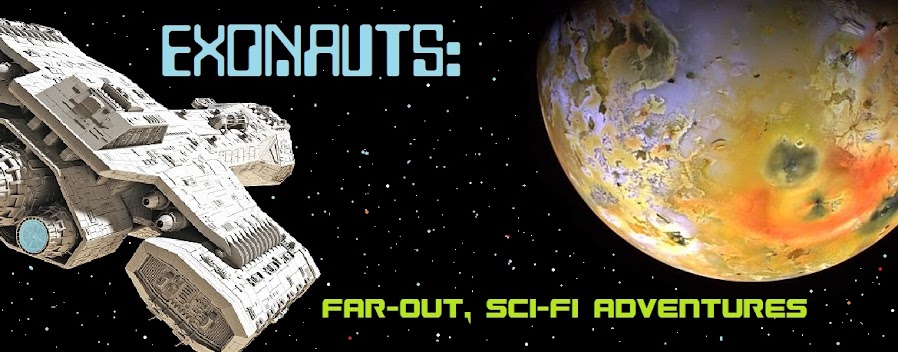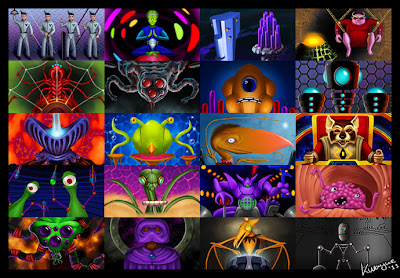As a college sophomore, I spent a not-so-small-part of my free time killing hostile alien invaders and scooping up iridium on distant planets in one of my favorite computer games--Star Control II.
 A friend had turned me on to the expansive and richly detailed universe in what was one of the more ambitious PC video games produced at that time. It was partly a point-and-click adventure where your decisions affected your future in the galaxy, but it had plenty of arcade-style gameplay were your skills with a gamepad were just as important.
A friend had turned me on to the expansive and richly detailed universe in what was one of the more ambitious PC video games produced at that time. It was partly a point-and-click adventure where your decisions affected your future in the galaxy, but it had plenty of arcade-style gameplay were your skills with a gamepad were just as important.Here's a few reasons I loved (and still do) the Star Control universe. For the purposes of this review, I'm basing my opinions on the second game in the series (as it's the one I played the most).
Note: This post will kick off a new series here on Exonauts: Saturday Star Control! Who wants SC aliens for X-plorers, raise your hands?
1. HUGE Roster of Alien Races
Few computer-based games had the incredible variety or sheer quantity of aliens populating their virtual universes as Star Control. By the time the third game in the series arrived, the SC cosmos was home to nearly 40 unique species with which to converse and combat. Throw in another dozen or so minor races to fill out the expansive storyline and you've got yourself an in-game pantheon that most pen-and-paper RPGs would blush at. :2. Fun and Fully-developed Story
Star Control II may have had the benefit of relying on a storyline set up in the previous game, but it expanded on the background to great effect. Before your adventure even begins you learn that the universe was explored early on by a race known as the Precursors. They're the "ancient ones" in the game and while they no longer exist, they've left traces of their technology behind--even allowing you to build your starship (we'll get to that in a minute).The precursor tech turns out to be fortuitous for a group of Earther colonists who happen to crash land and find....a starship factory!
 |
| Look! An entire underground starship factory! What are the chances?! |
 |
| Finally! A game where making nice with old girlfriends is a good way to build alliances. |
3. Explore Planets, Mine Resources, Get Cool Stuff
Raise your hand if you want to explore strange new worlds! Star Control II had VERY detailed star map, based on our own constellations, with planets that could be plundered for their natural resources. You'd send a probe module down to the surface to sniff around for goodies to extract and those findings varied in value (just as in a pen-and-paper RPG) and could be used to upgrade your own ship.It would have been really easy for the game developers to just hand-wave this portion of the game without including an actual joystick controlled rover, but to their credit they turned the boring (ha!) chore of finding resources into something more tactile and fun--you had to survive hostile environments, seismic disturbances, and a slew of hazards before your little vehicle gave out. And you only had a finite number of probes to begin with. It all made for a harrowing experience--exploring strange new worlds is dangerous!
4. Upgrade Your Starship, Grow Your Fleet!
I think my favorite part of the game was that you got to build your starship. You began with just a skeleton for a flagship built from ancient Precursor technology--just a bridge with some nacelles, strung together with a what literally appeared to be a spine. |
| That's as factory "stock" as it gets! |
Imagine if James Kirk had been given the bare minimum of superstructure for the Enterprise and then granted agency from Starfleet to upgrade as he so chose, and even acquire new ships to help their mission. That's the kind of game I want to play in--regardless of it being computer-based or one where funny dice are rolled.
5. Arcade-style Space Battles
Probably the thing that put Star Control over-the-top in terms of gameplay was it's arcade-style space combat. Let's face it, turn-based combat is interesting on a "I'm being strategic and using my mind to outsmart the enemy" type of fun. But in this game, you're careening wildly across a battlefield in space, frantically blasting away in panic-inducing ship-to-ship combat at the end of a joystick.There are basically two sides: you lead the Earth Alliance, a fleet made up of alliances you've made during the game. The opposing side is led by The Ur Quan, who command a fearsome armada. You're the underdog (in case you haven't figured that out).
The ships themselves are as unique as the alien races that built them. Every class of ship has two weapons, a primary and a secondary, and it takes skill and patience to master them all. The modes of attack vary: laser blasts, particle beams, missiles, fighter squadrons, explosive circle bursts, giant flying death disks reminiscent of the glaive from Krull--you name it. There's even a "Super Melee" mode where you can practice with ships from both sides of the war and build your own fantasy fleets!
Sure, it'd be fun to control your entire rag-tag fleet of alien allied starships in some big single-battle, a la Homeworld. But the sheer lunacy of gladiatorial combat in space--to the death, BTW--is what makes this particular game so memorable. It's essentially fusing fanboy fantasies of Luke Skywalker's X-wing pilot skills to the Captain Kirk's style of adventuring in the rest of the game. Best of all, you can fight head-to-head against the computer or one of your buddies!
A Legacy of Space Gaming Fun
It's hard to believe even now how the makers of Star Control got so many things right--throwing in so many aspects of space exploration and battle--without it ever feeling bloated. It's a testment to the developers and their obvious love of science fiction and space opera that the game is so fondly remembered by gamers today. |
| "Jim, I'm a doctor, not a firefighter!" |
The last official release of a Star Control product was back in 1996, and the game was later codified into an emulator of sorts. Sidenote: if you think pen-and-paper RPG simalcrimum are confusing, wait until you try sorting video games variations! The port is called the Ur-Quan Masters and it's literally the same game, but playable via Windows and touchscreen devices. Sequels and revivals of the series have been rumored for years, but it wasn't until this year that, I think, a true heir apparent of sorts arrived: Star Command.
Star Command is more of a pastiche of click-and-point amd simulation-style games games (Master of Orion and X-Com come to mind) it's infused with a great deal of DNA from Star Control. It features an impressive gallery of alien races to encounter, a much more customizable build-your-ship aspect, and incorporates the use of arcade-style mini games during combat. It's a fun game that probably emulates the Star Trek-style of adventuring better than anything to date. I'll get to reviewing it someday soon.
One thing's for sure, it owes a lot to games like the Star Control series!
Resources:
- Star Control Wikipedia entry
- List of aliens in Star Control I, II, and III
- Star-Control.com unofficial, but comprehensive resource
- Ur-Quan Masters (port of Star Control II)
- Ultranomicon - comprehensive Star Control wiki
- Support this Lego Cusoo project for Star Control spaceships and aliens!
- BBS thread for porting Star Control races to Savage Worlds RPG
- Star Control spaceships converted for Star Wars D6
Star Control images from Star-Control.com, some are of the Ur-Quan Masters version of Star Control II







Best game ever.
ReplyDeleteIt makes my bridge turn purple